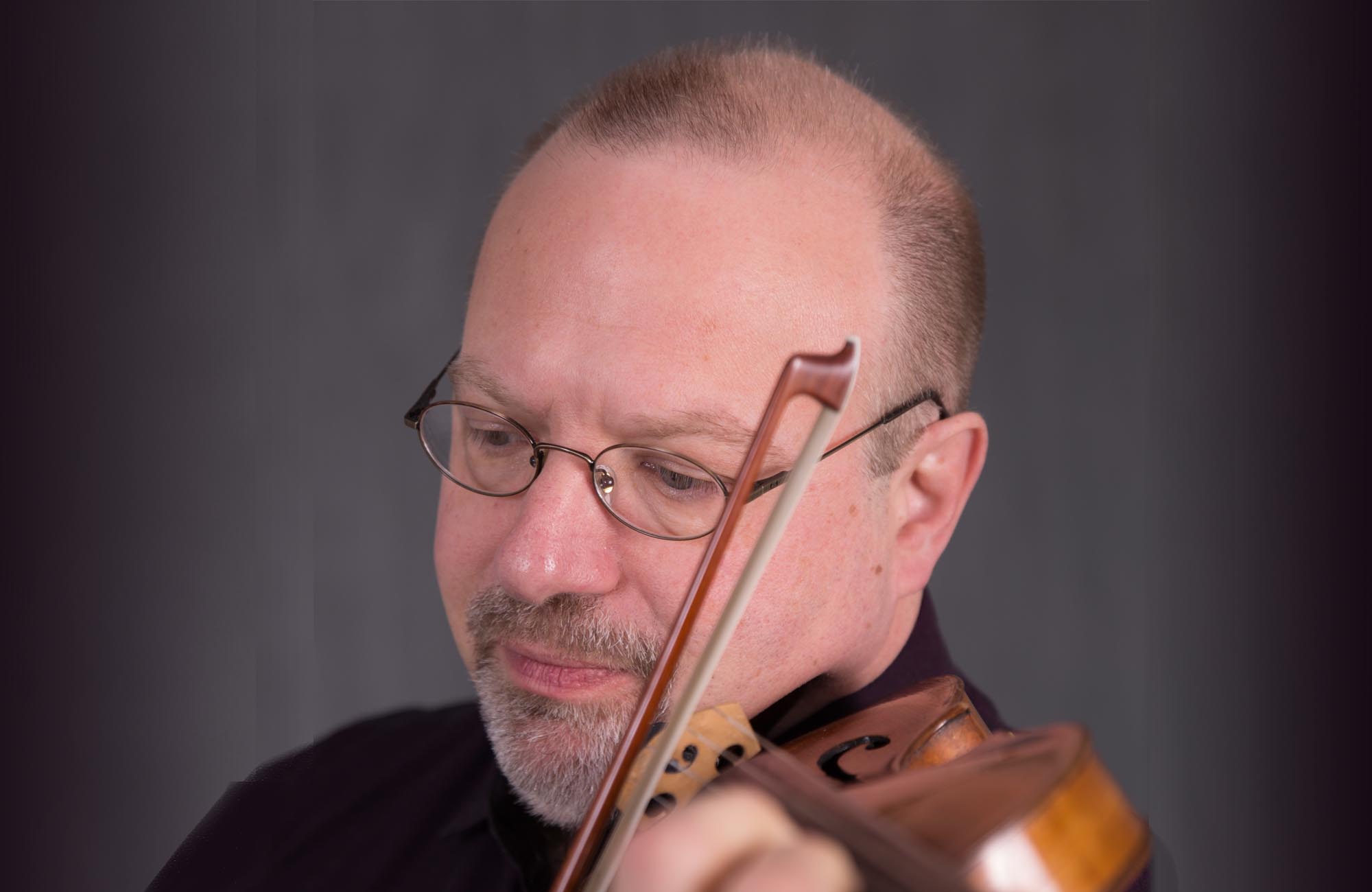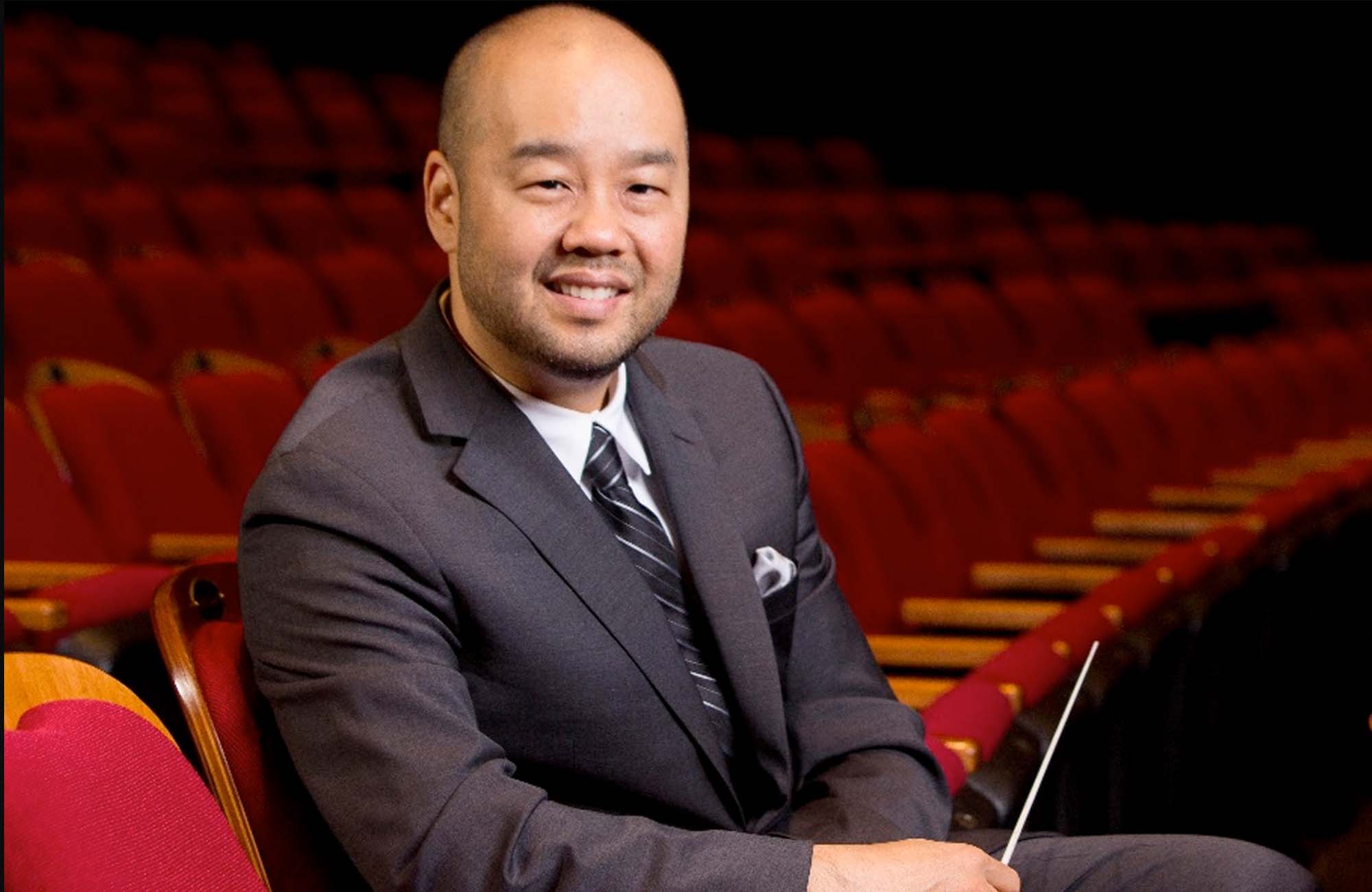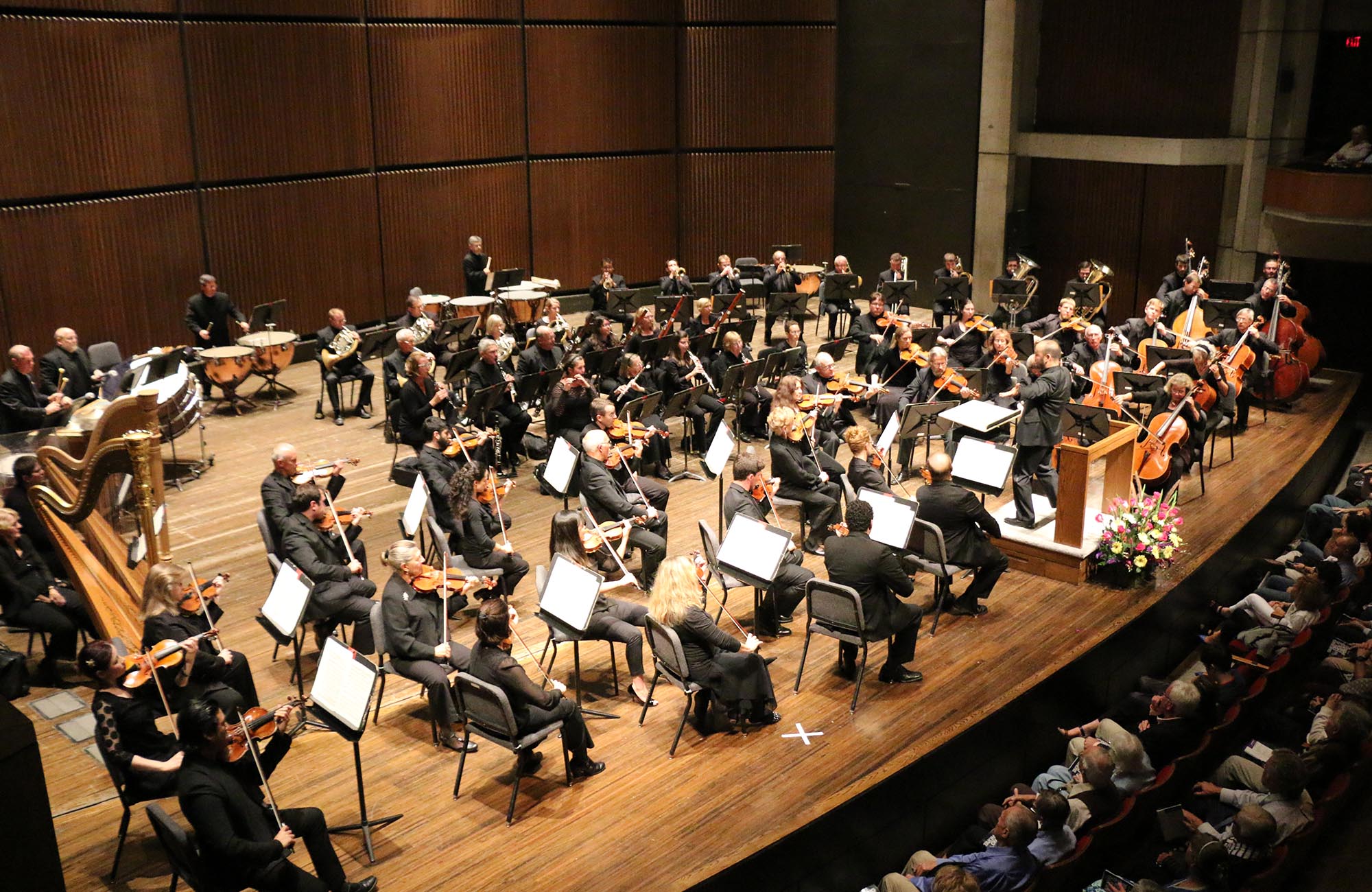PROGRAM
Performed on April 28 , 2018 at Course Hinds Theater
Lawrence Loh conducting; Peter Rovit, violin (Symphoria concertmaster)
Ralph Vaughan Williams
The Lark Ascending
Performed on April 28 , 2018 at Course Hinds Theater
Lawrence Loh conducting; Raquel Gonzalez, soprano; Vanessa Cariddi, mezzo-soprano; Cody Autin, tenor; Daniel Mobbs, baritone
Giuseppe Verdi
Messa da requiem
PROGRAM NOTES
Although the Requiem by Giuseppe Verdi (1813-1901) sets a traditional liturgical text, the composer himself was a non-believer, and the work itself has secular origins. When the composer Gioachino Rossini (himself a man known more for his gourmandizing than his piety) died in 1868, Verdi spearheaded an attempt to create a composite Requiem in his honor. A dozen other composers—now-forgotten men like Antonio Buzzolla and Alessandro Nini—were selected to contribute move-ments, with Verdi himself responsible for the closing “Libera me.” The history of classical music is sprinkled with such composite works, but few succeed, and this one was ...
Although the Requiem by Giuseppe Verdi (1813-1901) sets a traditional liturgical text, the composer himself was a non-believer, and the work itself has secular origins. When the composer Gioachino Rossini (himself a man known more for his gourmandizing than his piety) died in 1868, Verdi spearheaded an attempt to create a composite Requiem in his honor. A dozen other composers—now-forgotten men like Antonio Buzzolla and Alessandro Nini—were selected to contribute move-ments, with Verdi himself responsible for the closing “Libera me.” The history of classical music is sprinkled with such composite works, but few succeed, and this one was no exception. Yes, all of the music was actually composed (not always the case in such projects); but disputes among various involved parties scotched the premiere. The score was put away and only rediscovered a century later. It finally got its first hearing in 1988, and most of it is as mundane as you might expect.
Verdi, however, knew the quality of his own contribution—and at some point,
he decided to write a complete Requiem of his own. There’s some debate about precisely when he started working on it (musicologist David Rosen, in his excellent short book on the work, gives convincing evidence that it was in April, 1873). In any case, the death of revered Italian author Alessandro Manzoni in May 1873 provided the spur for him to start working in earnest, using that “Libera me,” with surprisingly few changes, as a springboard for his new composition in Manzoni’s honor. In a curious sense, then, the work we know today was written backwards. Many listeners experience that “Libera me” as a summation of the entire work, recalling both the spirit and a fair amount of specific music from earlier movements. In fact, though, those earlier movements were crafted in such a way that they would specifically lead to the already-written finale. (You may remember that the Mahler Fourth Symphony, heard on our last Masterworks concert, followed a similar route: the first three movements were composed to prepare the way for a finale that had been composed earlier.)
Beyond its original inspirations, the Requiem is non-liturgical in two more important senses. First, its musical idiom comes more from theatrical traditions than from religious traditions, a quality that infused the work with some controversy. At the time of the premiere, Hans von Bülow, one of the leading conductors and pianists of the time, dismissed it as “opera in ecclesiastical costume”—and while that storm has died down (even von Bülow changed his mind), the work remains a fixture in the concert hall, not in the church. It’s true, as conductor Larry Loh points out, that Verdi “writes music that’s reminiscent of chant,” which gives the work a mildly religious, as well as a vaguely timeless, flavor, as if it were “a collec-tion of centuries of expression.” (The soprano’s senza misura—freely, without the constraint of bar-lines—passage at the opening of the “Libera Me” is among the clearest examples.) It’s true, too, that “Verdi asks his singers not to sing in an overly operatic way.” Still, the theatrical elements are hard to miss, whether it be the spectacular effects of the “Dies Irae” (representing the Day of Judgment) with its onslaught of off-stage trumpets or the soprano’s high C at the climax of the “Libera Me.”
Second, its spiritual content is humanist rather than specifically Christian, much less Catholic—a quality, as Larry reminds us, that ties it to the Brahms German Requiem. This non-sectarian quality is so strong that during the Holocaust, pris-oners of the Terezín concentration camp, who learned the piece by rote from a single copy of the score, performed it sixteen times within about a year as an act of defiance. For them, Verdi’s depiction of the Day of Judgment was a forewarning to their Nazi captors.
In terms of its breadth of musical expression, the Requiem holds up to just about any work in the standard nineteenth-century repertoire. The harrowing “Dies Irae”; the bare, almost chant-like a capella duet for soprano and mezzo at the beginning of the “Agnus Dei”; the boisterous “Sanctus,” its lines joyously bouncing back and forth between two choral groups; what Larry calls the “giant plea” of the closing pages, the chorus barely whispering its final words: this is a work that seems to contain the entirety of human experience.
In fact, there’s enough here to fill an evening, and since its first performance, the work has often stood by itself on concert programs. But we decided to fill out the concert—the question was, with what? What could possibly provide a plausible opener? In the end, we decided on The Lark Ascending for violin and orchestra by Ralph Vaughan Williams (1872-1958). Vaughan Williams is often typecast as a reserved composer with a strong interest in the countryside, in folk music, and in music of the past. And while there’s a lot more range to his art than that cliché would suggest, The Lark Ascending, with its quiet rural spirit, would not provide evidence for anyone wanting to refute the stereotype. Inspired by a brief George Meredith poem, it’s a luminous and meditative piece attuned to natural beauty. The solo part avoids traditional romantic virtuosity almost entirely, in exchange, it demands the greatest delicacy and purity of tone. Originally begun as a work for violin and piano just around the outbreak the First World War, it was later recast for violin and small orchestra in 1919, and it’s hard not to hear it as a nostalgic evocation of calmer and simpler times. It seems an appropriate opener for this concert because its understatement provides such a clear counterweight to the heightened emotions of the Verdi. But it was also chosen because the two works, for all their outward differences, share a certain disposition. Vaughan Williams, like Verdi, was a non-believer; and like Verdi, he could nonetheless write music of transcendent spiritual quality.
Peter J. Rabinowitz
prabinowitz@ExperienceSymphoria.org
FEATURED ARTISTS

Violinist Peter Rovit (BM, Indiana University; MM, Hartt School; Professional Studies, Juilliard; DMA, SUNY Stony Brook) was among the last students of Josef Gingold at Indiana University where he also studied Baroque violin with Stanley Ritchie. Other teachers have included Mitchell Stern, Philip Setzer (Emerson Quartet), Cho-Liang Lin, Paul ...
Violinist Peter Rovit (BM, Indiana University; MM, Hartt School; Professional Studies, Juilliard; DMA, SUNY Stony Brook) was among the last students of Josef Gingold at Indiana University where he also studied Baroque violin with Stanley Ritchie. Other teachers have included Mitchell Stern, Philip Setzer (Emerson Quartet), Cho-Liang Lin, Paul Kantor and Donald Weilerstein. As a chamber musician, recitalist, and soloist he has performed throughout the United States and at music festivals such as Aspen, Taos, Yellow Barn, Hot Springs, Skaneateles, and Musical Spring in Saint Petersburg (Russia). A concerto competition winner at both the Hartt School and at SUNY Stony Brook, Mr. Rovit has also performed as a soloist with the Montgomery Symphony, the Fort Smith Symphony, the Oklahoma City Philharmonic, and the Tuscaloosa Symphony. He was a recipient of the prestigious Montgomery Symphony Violin Fellowship, has been a member of the Quartet Oklahoma, Associate Concertmaster of the Oklahoma City Philharmonic, and Concertmaster of the Tuscaloosa Symphony.
Mr. Rovit also loves to share his knowledge and experience with young musicians and has been on the string faculty of the University of Oklahoma and the University of Alabama. His students have gone on to study at such schools as Juilliard and Rice, and have won positions in professional orchestras, as well as the Chicago Civic Orchestra.
In his spare time, he enjoys reading, gardening, cooking, and finding imaginative ways to cook up those garden vegetables so that his children will eat them. Since having moved to Syracuse, he and his family have also enjoyed getting involved in winter sports such as snowshoeing, skating, and skiing.

Described as bringing an “artisan storyteller’s sensitivity… shaping passages with clarity and power via beautifully sculpted dynamics… revealing orchestral character not seen or heard before” (Arts Knoxville) Lawrence Loh enjoys a dynamic career as a conductor of orchestras all over the world.
After an extensive two ...
Described as bringing an “artisan storyteller’s sensitivity… shaping passages with clarity and power via beautifully sculpted dynamics… revealing orchestral character not seen or heard before” (Arts Knoxville) Lawrence Loh enjoys a dynamic career as a conductor of orchestras all over the world.
After an extensive two year search, Lawrence Loh was recently named Music Director of the Waco Symphony Orchestra beginning in the Spring of 2024. Since 2015, he has served as Music Director of The Syracuse Orchestra (formerly called Symphoria), the successor to the Syracuse Symphony Orchestra. “The connection between the organization and its audience is one of the qualities that’s come to define Syracuse’s symphony as it wraps up its 10th season, a milestone that might have seemed impossible at the beginning,” (Syracuse.com) The Syracuse Orchestra and Lawrence Loh show that it is possible to create a “new, more sustainable artistic institution from the ground up.”
Appointed Assistant Conductor of the Pittsburgh Symphony in 2005, Mr Loh was quickly promoted to Associate and Resident Conductor within the first three years of working with the PSO. Always a favorite among Pittsburgh audiences, Loh returns frequently to his adopted city to conduct the PSO in a variety of concerts. Mr. Loh previously served as Music Director of the West Virginia Symphony Orchestra, Music Director of the Northeastern Pennsylvania Philharmonic, Artistic Director and Principal Conductor of the Syracuse Opera, Music Director of the Pittsburgh Youth Symphony Orchestra, Associate Conductor of the Dallas Symphony Orchestra, Associate Conductor of the Colorado Symphony Orchestra and Music Director of the Denver Young Artists Orchestra.
Mr. Loh’s recent guest conducting engagements include the San Francisco Symphony, Dallas Symphony, North Carolina Symphony, Baltimore Symphony, Sarasota Orchestra, Florida Orchestra, Pensacola Symphony, Atlanta Symphony, National Symphony, Detroit Symphony, San Diego Symphony, Seattle Symphony, National Symphony (D.C.), Utah Symphony, Rochester Philharmonic, Indianapolis Symphony, Calgary Philharmonic, Buffalo Philharmonic, Albany Symphony and the Cathedral Choral Society at the Washington National Cathedral. His summer appearances include the festivals of Grant Park, Boston University Tanglewood Institute, Tanglewood with the Boston Pops, Chautauqua, Sun Valley, Shippensburg, Bravo Vail Valley, the Kinhaven Music School and the Performing Arts Institute (PA).
As a self-described “Star Wars geek” and film music enthusiast, Loh has conducted numerous sold-out John Williams and film music tribute concerts. Part of his appeal is his ability to serve as both host and conductor. “It is his enthusiasm for Williams’ music and the films for which it was written that is Loh’s great strength in this program. A fan’s enthusiasm drives his performances in broad strokes and details and fills his speaking to the audience with irresistible appeal. He used no cue cards. One felt he could speak at filibuster length on Williams’ music.” (Pittsburgh Tribune)
Mr Loh has assisted John Williams on multiple occasions and has worked with a wide range of pops artists from Chris Botti and Ann Hampton Callaway to Jason Alexander and Idina Menzel. As one of the most requested conductors for conducting Films in Concert, Loh has led Black Panther, Star Wars (Episodes 4-6), Jaws, Nightmare Before Christmas, Jurassic Park, Casablanca, The Wizard of Oz and Singin’ in the Rain, among other film productions.
Lawrence Loh received his Artist Diploma in Orchestral Conducting from Yale, his Masters in Choral Conducting from Indiana University and his Bachelor of Arts from the University of Rochester. Lawrence Loh was born in southern California of Korean parentage and raised in Carlisle, Pennsylvania. He and his wife Jennifer have a son, Charlie, and a daughter, Hilary. Follow him on instagram @conductorlarryloh or Facebook at @lawrencelohconductor or visit his website, www.lawrenceloh.com


